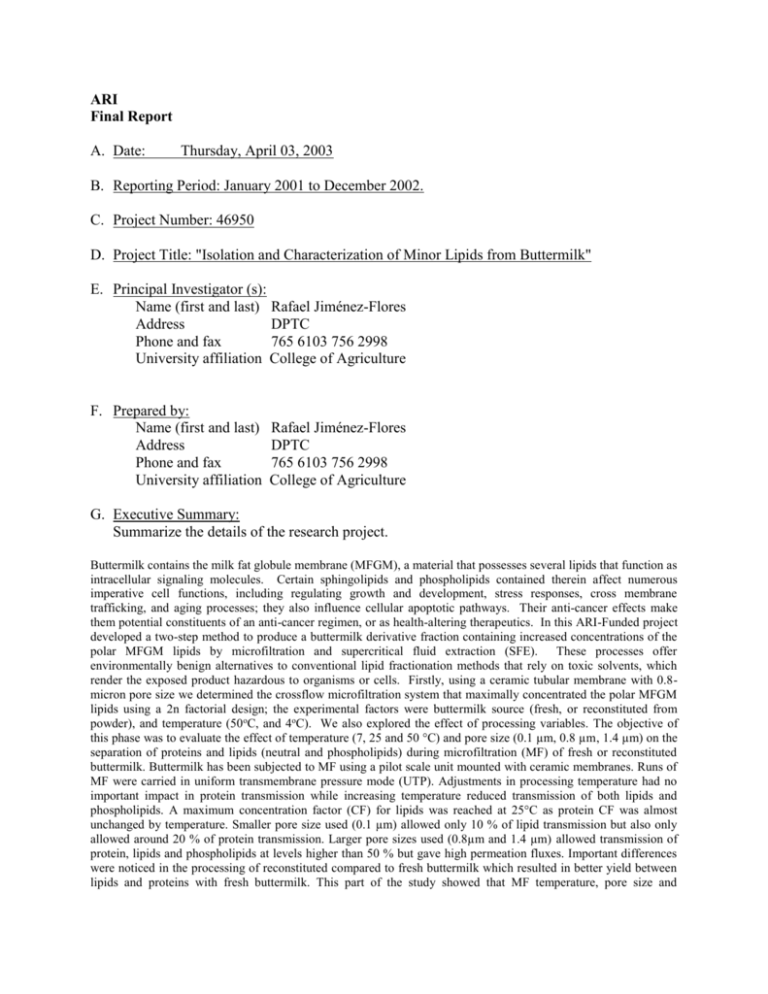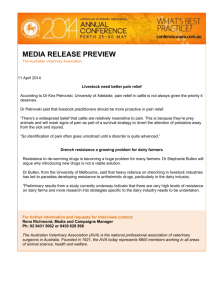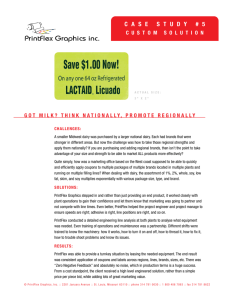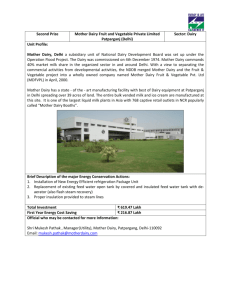CSU Agricultural Research Initiative
advertisement

ARI Final Report A. Date: Thursday, April 03, 2003 B. Reporting Period: January 2001 to December 2002. C. Project Number: 46950 D. Project Title: "Isolation and Characterization of Minor Lipids from Buttermilk" E. Principal Investigator (s): Name (first and last) Rafael Jiménez-Flores Address DPTC Phone and fax 765 6103 756 2998 University affiliation College of Agriculture F. Prepared by: Name (first and last) Address Phone and fax University affiliation Rafael Jiménez-Flores DPTC 765 6103 756 2998 College of Agriculture G. Executive Summary: Summarize the details of the research project. Buttermilk contains the milk fat globule membrane (MFGM), a material that possesses several lipids that function as intracellular signaling molecules. Certain sphingolipids and phospholipids contained therein affect numerous imperative cell functions, including regulating growth and development, stress responses, cross membrane trafficking, and aging processes; they also influence cellular apoptotic pathways. Their anti-cancer effects make them potential constituents of an anti-cancer regimen, or as health-altering therapeutics. In this ARI-Funded project developed a two-step method to produce a buttermilk derivative fraction containing increased concentrations of the polar MFGM lipids by microfiltration and supercritical fluid extraction (SFE). These processes offer environmentally benign alternatives to conventional lipid fractionation methods that rely on toxic solvents, which render the exposed product hazardous to organisms or cells. Firstly, using a ceramic tubular membrane with 0.8micron pore size we determined the crossflow microfiltration system that maximally concentrated the polar MFGM lipids using a 2n factorial design; the experimental factors were buttermilk source (fresh, or reconstituted from powder), and temperature (50oC, and 4oC). We also explored the effect of processing variables. The objective of this phase was to evaluate the effect of temperature (7, 25 and 50 °C) and pore size (0.1 µm, 0.8 µm, 1.4 µm) on the separation of proteins and lipids (neutral and phospholipids) during microfiltration (MF) of fresh or reconstituted buttermilk. Buttermilk has been subjected to MF using a pilot scale unit mounted with ceramic membranes. Runs of MF were carried in uniform transmembrane pressure mode (UTP). Adjustments in processing temperature had no important impact in protein transmission while increasing temperature reduced transmission of both lipids and phospholipids. A maximum concentration factor (CF) for lipids was reached at 25°C as protein CF was almost unchanged by temperature. Smaller pore size used (0.1 µm) allowed only 10 % of lipid transmission but also only allowed around 20 % of protein transmission. Larger pore sizes used (0.8µm and 1.4 µm) allowed transmission of protein, lipids and phospholipids at levels higher than 50 % but gave high permeation fluxes. Important differences were noticed in the processing of reconstituted compared to fresh buttermilk which resulted in better yield between lipids and proteins with fresh buttermilk. This part of the study showed that MF temperature, pore size and buttermilk type influence fractionation and that MF can be combined with other treatments to separate lipids and proteins for the production of novel ingredients In our second phase, a SFE process using supercritical carbon dioxide (SC-CO2) removed exclusively nonpolar lipid material from the microfiltered buttermilk product. Lipid analysis by thin layer chromatography (TLC), and fatty acid methyl ester analysis by capillary gas chromatography (GC) showed that after SFE the product contained a significantly reduced concentration of nonpolar lipids, and a significantly increased concentration of polar lipids derived from the MFGM. Particle size analysis revealed shifts in the particle size distribution after SFE. The efficiency of the SFE system using the microfiltration-enriched powder was compared favorably to using buttermilk powder. H. Major Accomplishments: State the situation of the research and the findings. Describe how the research was beneficial as well as the solutions that were found and by what means. Identify these points by numbers and/or bullets. This project yielded the following results: Johanna Astaire-Kaplan graduated with a Master’s degree, part of a post doctoral fellow was possible thanks to supply funding and three undergraduates worked aiding in the project. She is being nominated for the Cal Poly Outstanding Graduate Student Thesis Award. The scientific merit in this work was outstanding. Results from his work were presented in the Annual Meeting of the American Dairy Association held in Quebec, Canada. The response to the poster presented was outstanding surpassing 150 inquiries. This work was also presented in the Annual Symposium of Dry Dairy Ingredients in Shell Beach, event organized by the DPTC for the benefit of the dairy industry in the USA. With over 100 attendants from the industry and 5 countries represented, including Professors from France, Australia, New Zealand, and participants from at least 10 states from the US, these results caused a high level of enthusiasm. I have been invited to present the results of this work at the International Dairy Federation World Dairy Summit, in a Pre-Summit Symposium on Innovative Research. Will take place in Bruges, Belgium on September 2003. (I will be the ONLY speaker from an undergraduate institution in the program). Most significantly in the academic area, this work allowed the establishment of a very important program of collaboration with the University of California, Davis, where in perfect coordination of goals, we have established (and hope to continue to do so), a program in which the practical development of dairy-based ingredients containing this highly valuable lipids, are studied and used in nutritional studies and programs of research. This effort has expanded not only in both universities but beyond the state and even the country, with interested academic and medical nutrition parties collaborating. 2 I. Impact Statements: List the project impacts in priority order using as many numbers as needed. 1. Program has gained access to high profile events at the National and International level 2. We have established a productive collaboration of research and education with the University of California Davis program on Food Science and Human Nutrition. 3. The results of this work advanced important concepts on the development of a process to concentrate proteins and lipids that are normally found in low concentrations in milk. J. Dissemination, publications and presentations of research: Presentations at the Annual Meeting of the ADSA. Quebec, CA. July 2003 Astaire Johanna C., Harit K. Vyas, Rafael Jiménez-Flores Extraction of lipids from buttermilk using supercritical carbon dioxide Dairy Products Technology Center, California Polytechnic State University, San Luis Obispo, CA. Vyas Harit K., Johanna C. Astaire, Rafael Jiménez-Flores Buttermilk fractionation by microfiltration Dairy Products Technology Center, California Polytechnic State University, San Luis Obispo, CA. Fifth Symposium on Advances in Dairy Products Technology. “Concentrated and Dried Dairy Ingredients” February 24-25, 2003 High Value Fractions From Buttermilk Obispo, CA R. Jimenez, Cal Poly State University, San Luis Peer-Reviewed Articles Astaire, J. C., R. Ward, J. B. German and R. Jiménez-Flores. 2003. Concentration of Polar MFGM Lipids From Buttermilk by Microfiltration and Supercritical Fluid Extraction. Journal of Dairy Science. (Accepted for publication 1.2003) Morin. Pierre, R. Jiménez-Flores and Y. Pouliot.2003. Effect of Temperature and Pore Size on the Fractionation of Fresh and Reconstituted Buttermilk by Microfiltration. (Submitted JDS) In addition all the principles and techniques developed, principles learnt and academic relationships established, now form part of the teaching portfolio in my program. 3 Below is a copy of the courses I am involved at cal poly, directly from “Black Board” Courses you are teaching: Spring 2003 INDIVIDUAL STUDY GENERAL DAIRY MANUFACTURING GENERAL DAIRY MANUFACTURING SENIOR PROJECT SPECIAL PROBLEMS GENERAL DAIRY MANUFACTURING SENIOR PROJECT GRAD INTERNSHIP IN DAIRY SCIENCE BIOENGINEERING FUNDAMENTALS THESIS IN DAIRY SCIENCE INDIVIDUAL STUDY/DAIRY SCIENCE Winter 2003 SPECIAL PROBLEMS SPECIAL PROBLEMS SENIOR PROJECT SENIOR PROJECT GRAD INTERNSHIP IN DAIRY SCIENCE THESIS IN DAIRY SCIENCE BioEng Fund 213-72 Monday Winter03 GRAD SEMINAR IN DAIRY SCIENCE BioEng Fund 213-71 Thursday Winter03 GRAD SEMINAR IN DAIRY SCIENCE INDIVIDUAL STUDY/DAIRY SCIENCE Fall 2002 SPECIAL PROBLEMS SPECIAL PROBLEMS SENIOR PROJECT INDIVIDUAL STUDY/DAIRY SCIENCE GRAD INTERNSHIP IN DAIRY SCIENCE 4 RECENT DEVELPMNTS/DSCI & TECH GRAD SEMINAR IN DAIRY SCIENCE THESIS IN DAIRY SCIENCE Bioengineering Fund-70-Fall 02 Bioengineering Fund-71-Fall 02 5






